Blotting is a procedure used by scientist to separate different types of molecules. Through the blotting method, researchers can separate one protein from other types of proteins.
How is blotting done? It is done by letting a mixture of DNA, RNA, and protein flow through a slab of gel, which will enable the minute molecules to move faster than the bigger molecules. The molecules are pressed against a membrane which moves the molecules onto the membrane. (1, 2, and 3)
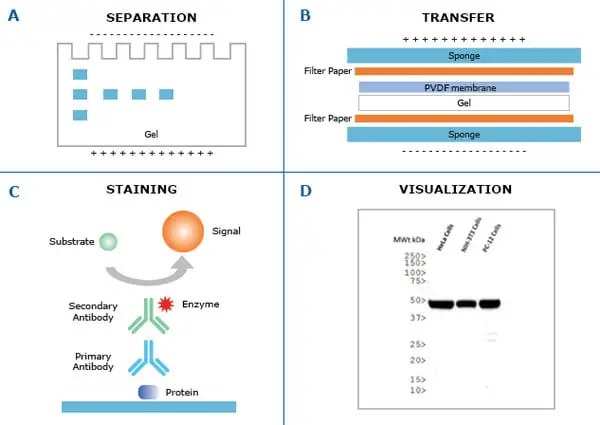
There are various types of blotting methods: western blot, southern blot, and northern blot. Let us take a look at the differences between the three:
Terms commonly used in performing blotting procedures.
- Electrophoresis – A method used in a laboratory setting to separate charged molecules such as DNA with relation to the molecule’s size.
- Capillary transfer – The ability of the liquid to flow in a narrow space.
- Denature – To alter or to take away the natural qualities, to destroy the characteristic properties using heat, acidity, and other measures.
- Hybridization – It is a phenomenon in which a single-stranded DNA/RNA molecule anneals to complementary DNA/RNA. (1, 2, 3, and 4)
What is Western Blotting ?
This procedure separates protein according to its size and in a straight column so that researchers can easily compare the amount of protein across various samples that run next to each other.
Western blotting helps to detect a particular amino acid sequence in a mixture of protein. It consists of different steps such as electrophoresis, transfer, and detection of specific proteins. Another term for western blot is protein blot or immune-blotting. It is primarily used to:
- Identifying the number of protein in a given sample.
- Detecting the presence of the virus and/or bacteria in the serum.
- Detecting the presence of HIV antibody in serum.
- Detecting defective proteins.
- Used as a definite measure for Lyme disease, herpes, hepatitis B, and Creutzfeldt-Jacob disease. (4, 5, and 6)

Image 2: The image shows the procedures involved in western blotting method.
Picture Source: mybiosource.com
Frequently Asked Questions about Western Blotting
Q1. What are the factors that could affect the actual band size?
Factors that could affect the actual band size include post-translational modification, post-translation cleavage, splice variants and isoforms, and relative charge.
Q2. How much sample is needed?
The typical sample needed is 20 to 30 µg of total protein per well.
Q3. Does the sample need to be reduced and denatured?
The need to reduce and denature the sample primarily depend on the instruction per se. there are instances when it needs to be reduced and denatured and there are also instances when it shouldn’t be reduced and denatured. (2, 3, 4, and 5)
What is Northern Blotting ?
This type of blotting method is used to detect RNA. RNA is released once cells are broken open. Through Northern blotting procedure, researchers can easily compare the cell type that contains the highest number of RNA. It also allows the researchers to find out if the cells from a certain disease contain less RNA or more RNA.
It also helps in determining the progression of a certain disease based on RNA production. Northern blotting consists of the following steps: electrophoresis, transfer, and detection of specific sequences. Northern blotting is primarily used to:
- Identify the specific RNA sequence in a given sample.
- It helps in disease diagnosis.
- It is useful in gene expression studies. (5, 6, and 7)
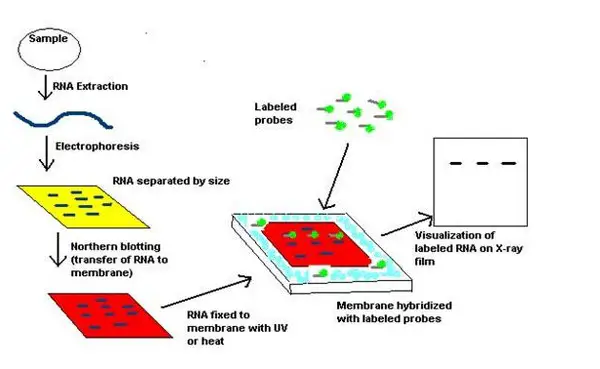
Image 3: The procedures involved in northern blotting procedure.
Picture Source: mybiosource.com
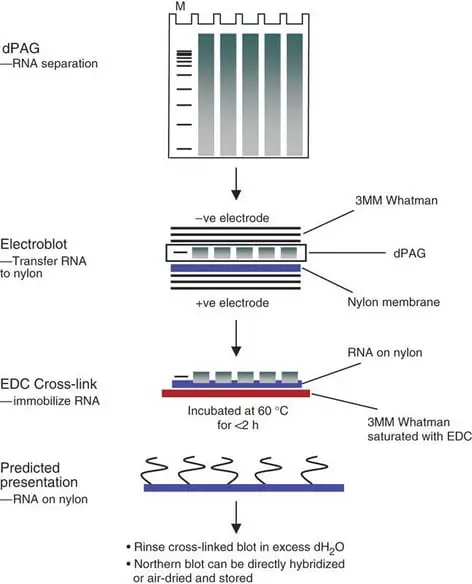
Image 4: The improved northern blotting procedure for enhanced detection of small RNA.
Picture Source: springernature.com
Frequently Asked Questions about Northern Blot
Q1. How to make your RNA?
There are RNA isolation kits available today. So, making your RNA is easy. Just make sure you observe basic precautionary measures.
Q2. How to make your RNA probes?
There are two ways to make RNA probes: labeling a DNA oligo complementary to your RNA and randomly label a PCR product that is homologous to your sequence.
Q3. How to detect your RNA?
Detecting the RNA can be done in a number of ways such as through an x-ray film and digital imaging system. (5, 6, and 7)
What is Southern Blotting ?
It is the oldest and the original blotting method. It was invented by Edwin Southern; thus, the name was given to the procedure. Southern blotting helps in detecting the amount of DNA in a given mixture.
It separates DNA from various cell types according to its size. Southern blotting steps include the following: electrophoresis, transfer, and detection of specific sequences. Southern blotting method is used for the following reasons:
- To detect a specific DNA sequence in a given sample.
- It is used in paternity testing.
- It is used in DNA fingerprinting.
- It is used for victim identification.
- It is used for identifying criminals.
- It is useful in genetic diseases and infectious agents.
- It is used in mutation and identification of gene rearrangement. (8, 9, and 10)
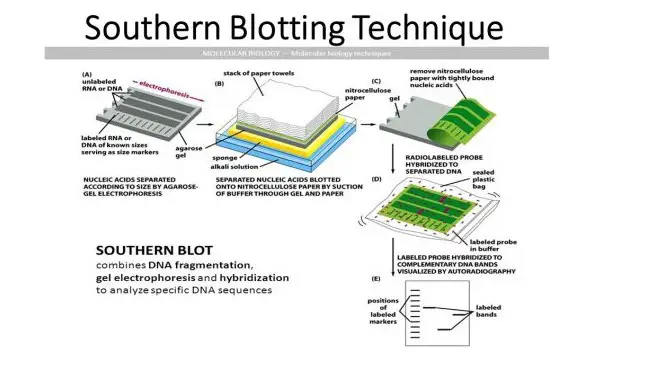
Image 5: The image shows the procedures involved in a southern blotting method.
Picture Source: onlinebiologynotes.com
Frequently Asked Questions about Southern Blotting
Q1. How much DNA is needed in performing southern blot?
The amount of DNA needed in performing southern blot primarily depends on the size and particular activity of the probe.
Other Blotting Methods
The three above mentioned blotting techniques (Western, Southern, and Northern) are modified in various ways to help in identifying slightly different molecules. Other blotting methods include:
- Southwestern blot – it detects protein molecules stuck to DNA.
- Northwestern blot – It detects protein molecules stuck in RNA.
- Farwestern blot – It is used to detect protein molecules stuck to other proteins. (1, 2, and 3)
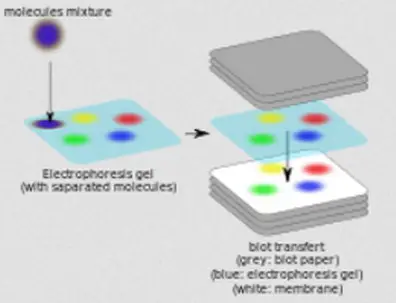
Image 6: Southwestern blotting procedure.
Picture Source: wikimedia.org

Image 7: Northwestern blotting method.
Picture Source: wikimedia.org

Image 8: The image shows as Farwestern blot method.
Picture Source: creative-proteomics.com
What are the similarities between western blot, northern blot, and southern blot?
- They are techniques used to detect a particular type of macromolecule within a sample.
- These three blotting procedures include three basic steps: electrophoresis, transfer, and detection of specific proteins.
- All three blotting methods need denaturation and blocking with the excess corresponding protein molecule.
- All three blotting methods are useful in medicine and biotechnology.
Now that we know the similarities of the three blotting methods, let us now take a look at the differences between the three. Refer to the table below for detailed information about the differences between Southern blot, northern blot, and western blot. (1, 3, 4, and 5)

Image 9: Edward Southern was the one who developed Southern blot in 1975.
Picture Source: slidesharecdn.com

Image 10: David Kemp and colleagues were the ones who developed northern blot.
Picture Source: science.org.au
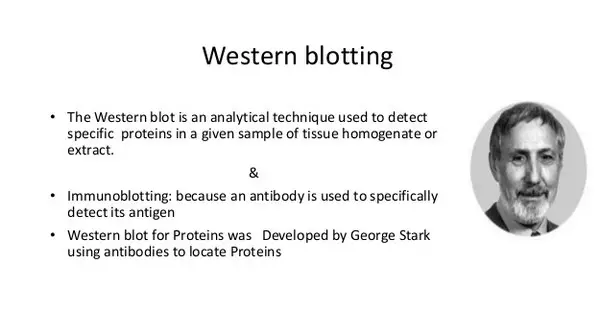
Image 11: George Stark and his group were the ones responsible for the development of western blot.

Picture Source: slidesharecdn.com
Image 12: The image shows the basic comparison between southern blot, northern blot, and western blot.
| Point of comparison | Southern Blot | Northern Blot | Western Blot |
| Definition | A procedure used to identify a specific sequence of DNA. (10) | It is an adaptation of the southern blot procedure, which is useful in detecting a specific sequence of DNA through hybridization with complementary DNA. (9) | A blotting procedure used for identifying a specific amino acid sequence in proteins. |
| Developed by | Edward M. Southern in 1975 | James Alwine, David Kemp, and George Stark in 1977 | George Stark’s group at Stanford University in 1979 |
| Types of molecules detected | Specific DNA sequence | Specific RNA sequence | Specific proteins |
| Gel electrophoresis | Agarose gel electrophoresis | Denaturing of formaldehyde agarose gel | It involves SDS PAGE/ Polyacrylamide gel |
| Blotting procedure | Capillary transfer | Capillary transfer | Electric transfer |
| Probes | DNA probes | cDNA probes | Primary and secondary antibodies |
| Preparation of sample | The sample needs to be denaturated. | The sample is in its native state. | The sample is in its native state. |
| Application | To detect a specific DNA sequence in a given sample.It is used in paternity testing.It is used in DNA fingerprinting.It is used for victim identification.It is used for identifying criminals.It is useful in genetic diseases and infectious agents.It is used in mutation and identification of gene rearrangement. | • Identify the specific RNA sequence in a given sample.• It helps in disease diagnosis.• It is useful in gene expression studies. | • Identifying the number of protein in a given sample.• Detecting the presence of the virus and/or bacteria in the serum.• Detecting the presence of HIV antibody in serum.• Detecting defective proteins.• Used as a definite measure for Lyme disease, herpes, hepatitis B, and Creutzfeldt-Jacob disease. (5, 8) |
| Detection system | Autoradiograph, Detection of light, and Changes in color | Autoradiograph, Detection of light, and Changes in color | Detection of light and Changes in color |
Blotting is a special method used to identify a specific DNA, RNA, and protein from a given sample. There are different types of blotting procedures but the three common types are a northern blot, southern blot, and western blot. These three blotting methods have similarities but different in a lot of things. One of the primary differences between the three is the type of macromolecule they detect.
References
- https://en.wikipedia.org/wiki/Blot_(biology)
- https://labmedicineblog.com/2016/05/02/blotting-and-probing-techniques/
- https://www.proteinatlas.org/learn/method/western+blot
- https://en.wikipedia.org/wiki/Western_blot
- https://en.wikipedia.org/wiki/Northern_blot
- https://www.mybiosource.com/learn/testing-procedures/northern-blotting/
- https://en.wikipedia.org/wiki/Southern_blot
- https://askabiologist.asu.edu/southern-blotting
- https://www.slideshare.net/RaviRaj129/southern-northern-and-western-blotting-methods-in-genetic-engineering
- https://www.aaas.org/southern-northern-western-and-eastern-blots
